Teaching Your Dog No
By Michele Welton, Dog Trainer, Breed Selection Consultant, Author of 15 Dog Books

Mama says, "No! Not allowed!" Puppy says, "Yes, ma'am..."
When you tell your pup "No", you want him to learn:
- that this particular behavior is not allowed
- that he must stop the behavior
- that he should not repeat it
Have you already taken your pup to an obedience class? If so, you might have been told that you should stop him from doing something by redirecting his attention from an undesirable behavior to a better behavior.
For example, suppose he's chewing on your hand. You're told to pick up a toy and wiggle it on the floor so that he switches his attention to the toy. Now he's biting on something appropriate instead of your hand.
Alternatively, you're told to remove whatever the pup is acting inappropriately toward. For example, suppose he's stealing used tissues from the wastebasket beside the sofa. You're told to move the wastebasket out of his reach. Or remove the pup from the room.
Now, redirection and removal work fine with very young puppies who have a short attention span and an "out of sight, out of mind" thought process. These techniques are also effective for a few older pups and even for some very sensitive adult dogs.
Unfortunately, if those techniques are the only ones you're taught...
they will eventually fail.
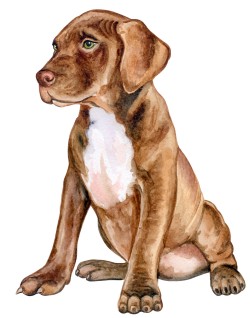 At some point – guaranteed – your pup will be so determined to bark, chase the cat, mouth your hand, jump on people, charge the door when the doorbell rings, etc. that he ignores your attempts at redirection and removal.
At some point – guaranteed – your pup will be so determined to bark, chase the cat, mouth your hand, jump on people, charge the door when the doorbell rings, etc. that he ignores your attempts at redirection and removal.
And honestly, how far can you go with this, anyway?
- When your hands are black and blue from his "playful" nips, should you keep waving a toy in Puppy's face hoping to get him to bite it instead?
- Should you remove the Christmas tree because your pup keeps pulling off the ornaments? Perhaps you should remove the pup by banishing him to the basement? One family suspended their Christmas tree from the ceiling so their dog couldn't reach it. Ugh!
Or should you simply teach him to STOP doing certain things?
I think you know my answer... "Yes, you should teach him to stop doing certain things."
In fact, handing your puppy a toy or a treat when he's chewing on your hand could be viewed as rewarding him for chewing on your hand. Pups repeat behaviors that bring them a reward. Not exactly what you want, right?
At some point, every dog in the world needs to learn the meaning of "No!" and AH-ah!"
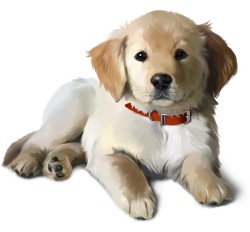 All parents and grandparents recognize the sound "AH-ah!"It's an abrupt guttural sound that comes out of our mouths instinctively when a toddler does something alarming.
All parents and grandparents recognize the sound "AH-ah!"It's an abrupt guttural sound that comes out of our mouths instinctively when a toddler does something alarming.
Now I don't mean a playful, sing-song caution ("ah-ah-AHHH...") that you might use with a child who is reaching for a cookie before supper.
I mean the sharp, alarmed "AH-ah!" that bursts out of your throat when that child is reaching toward a hot stove!
"AH-ah" has a couple of advantages over "No."
- "AH-ah" bursts from your throat more quickly than you can form your lips around "No." Make it a quick, choppy, urgent sound that Think of the toddler's hand so close to the hot stove!
- "AH-ah" may be a better word to use than "No" if you've been saying "No" to a dog for a long time and he has developed the habit of ignoring it. It can be a good idea to start fresh with "AH-ah", adding the corrective techniques we'll be discussing in a moment.
I use both words interchangeably, so my dogs learn both words.
Try not to use your pup's name when you say "No" or "AH-ah" so he doesn't associate his name with anything negative. However, if you have multiple dogs and one of them does something undesirable while the other one is also in the room... you should use the name of the guilty one so the innocent one doesn't feel reprimanded.
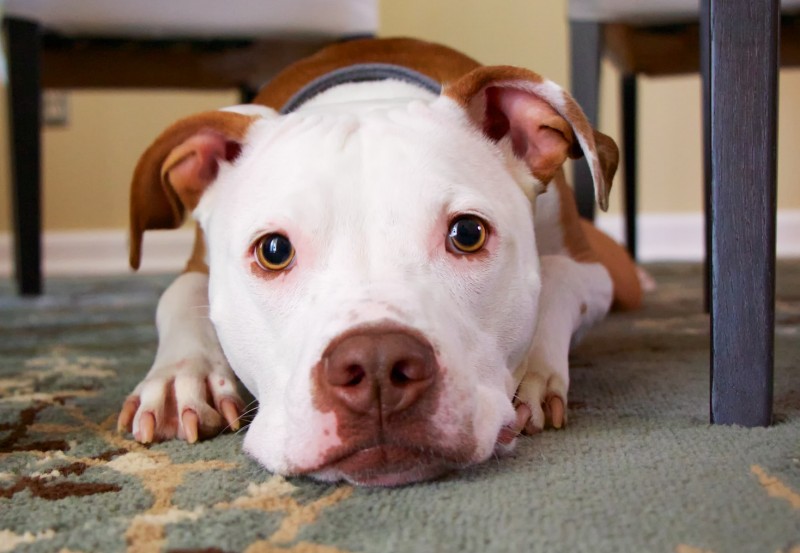
"No?? No?? What do you mean, No?"
You might be thinking, "But I say 'No' all the time, yet my pup doesn't stop what he's doing!"
That's right, if all you do is SAY it, it won't mean a thing to your dog. He wasn't born understanding that our sounds have meaning.
To a dog, no is just a sound, no more meaningful than a whistling teapot. A No sound is meaningless unless and until you show your pup that it means "Stop – not allowed."
Say "No" AS your pup is doing something you don't want (barking, jumping, chewing on the table leg, pestering the cat).
No more than one second later, add a corrective technique that actually makes him stop the behavior. I'll give you examples in a minute.
When you're first teaching your pup what No means, never say the sound without also doing the corrective technique.
Because in the beginning, it's the corrective technique – not the sound No – that makes your dog stop the behavior.
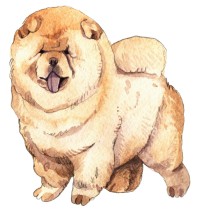 But since you're pairing the sound with the corrective technique, at some point you'll be able to just say "No" and your pup will stop whatever he's doing so quickly that you won't have time to add the corrective technique.
But since you're pairing the sound with the corrective technique, at some point you'll be able to just say "No" and your pup will stop whatever he's doing so quickly that you won't have time to add the corrective technique.
Once that happens.... once your pup stops what he's doing when you say "No".... can you stop adding the corrective technique?
It depends on your particular dog. If you stop adding an actual correction or if you add a correction only sometimes, some clever pups will go right back to repeating the behavior you were trying to stop. These pups have learned, you see, that your No sound doesn't always come with a negative consequence. So at any given time, they might choose to ignore the No sound, hoping that THIS could be one of those times when you're not going to enforce it.
Therefore, in the beginning when you're teaching No, you should try to pair it every time with an actual corrective technique.
The great news is that once you've been working with your pup for a while and you have a great leader-follower relationship, you can just say "No." I can't remember the last time I had to use any corrective technique with any of my current dogs, because a simple "No" stops ANY behavior. In fact, they seldom DO any behavior that even requires a No. Something to look forward to!
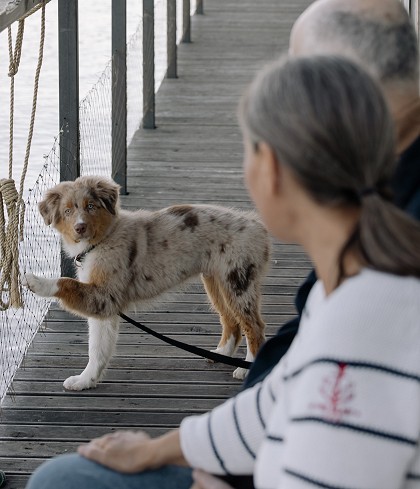
"Gonna tear this fence down and leap into the ocean... or maybe get my toenails caught in the wire and rip them off... No??"
Corrective techniques... what are they?
- A leash tug is the most common technique I use for stopping an undesirable behavior.
(1) Grasp the leash 6 to 18 inches from your pup's collar. (2) Drop your hand to the same height off the ground as the collar. (3) Move your hand toward the collar to create a little slack in the leash. (4) Tug the leash sideways and parallel to the ground – a quick (one-second) tug that's just enough to jolt the pup a bit and make him stop the undesirable behavior.
A young or sensitive puppy will need only a mild tug. However, a common mistake is to NAG a strong, determined pup with tiny little tugs that he pays no attention to. Nagging is annoying to a dog. If ONE tug doesn't interrupt and stop the pup's behavior, the second tug should be very firm; if that too is ineffective, try a different kind of corrective technique.
 A puff of compressed air. The Pet Corrector® by The Company of Animals is a small hand-held device that makes a soft, startling hissing sound, which can interrupt bad behavior.
A puff of compressed air. The Pet Corrector® by The Company of Animals is a small hand-held device that makes a soft, startling hissing sound, which can interrupt bad behavior.- A harmless spray of water from a plastic spray bottle or squirt gun. In shorthand, you want the pup to learn that "doing this behavior → the No sound → wet."
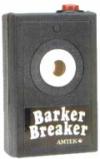 A sudden, sharp noise. The Barker Breaker by the Amtek Company is a small handheld device that makes a shrill sound when you press the button. The sound startles many puppies, causing them to stop whatever they're doing (whether barking or something else). Just be forewarned that it's loud and shrill to human ears, too! A cheaper option is to put coins, or small screws or other fasteners, inside a metal can, tape the top shut, and shake the can.
A sudden, sharp noise. The Barker Breaker by the Amtek Company is a small handheld device that makes a shrill sound when you press the button. The sound startles many puppies, causing them to stop whatever they're doing (whether barking or something else). Just be forewarned that it's loud and shrill to human ears, too! A cheaper option is to put coins, or small screws or other fasteners, inside a metal can, tape the top shut, and shake the can.
Every pup is different. Some consider squirts of water to be great fun, but don't like noise. Others are unfazed by noise but dislike getting wet. You never know what will work for any particular pup until you try it.
Also, some corrective techniques work well for certain behaviors, but less well for other behaviors. In some of my other training articles, I recommend additional techniques for common misbehaviors such as mouthing and nipping, jumping on people, pulling on the leash, aggression/reactivity, and so on.
Will corrections harm your relationship with your dog?
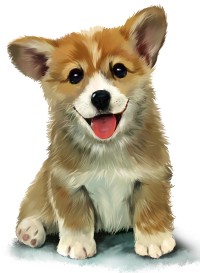 Absolutely not. In fact, corrections strengthen your relationship because the pup can see that you are making the rules about what he can and can't do. That reassures him that you've got the leadership position properly covered.
Absolutely not. In fact, corrections strengthen your relationship because the pup can see that you are making the rules about what he can and can't do. That reassures him that you've got the leadership position properly covered.
Then he can relax and be a good follower , which is much less stressful for a dog than trying to be a leader.
Does that mean pups enjoy corrections? Of course not.
Dogs aren't going to act happy when you make them do something they don't want to do, or stop them from doing something they want to do. When things don't go his way, it's normal for a dog to flatten his ears, drop his tail, and "look sad."
I'm sure your kids have sulked when they weren't happy with one of your parental decisions. Heck, you and I did the same thing when we were kids! But we learned a valuable lesson about consequences and we quickly got over our pouting.
Establishing the proper leader-follower relationship that your pup thrives on will ensure his long-term psychological health. All of us – adults, children, and dogs – make better decisions once we discover that there are indeed rules in life and that we are held accountable for our actions.
Pups who haven't been taught what "No" means will one day try doing something that endangers their lives. The owner is powerless to stop it because their pup doesn't know what "No" means. This is not fair to the dog. Owners who truly care about their pup's future life would never withhold the vital lesson that "No" means "Stop Immediately."
My best-selling books – now available FREE on my website
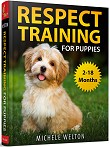 Respect Training For Puppies: 30 seconds to a calm, polite, well-behaved puppy is for puppies 2 to 18 months old. Your puppy will learn the 21 skills that all family dogs need to know. Click here to read for free.
Respect Training For Puppies: 30 seconds to a calm, polite, well-behaved puppy is for puppies 2 to 18 months old. Your puppy will learn the 21 skills that all family dogs need to know. Click here to read for free.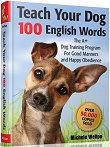 Teach Your Dog 100 English Words is a unique Vocabulary and Respect Training Program that will teach your adult dog to listen to you and do what you say. Click here to read for free.
Teach Your Dog 100 English Words is a unique Vocabulary and Respect Training Program that will teach your adult dog to listen to you and do what you say. Click here to read for free.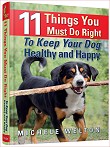 11 Things You Must Do Right To Keep Your Dog Healthy and Happy helps your dog live a longer, healthier life. Get my honest advice about all 11 Things before you bring home your new puppy, because some mistakes with early health care cannot be undone. Click here to read for free.
11 Things You Must Do Right To Keep Your Dog Healthy and Happy helps your dog live a longer, healthier life. Get my honest advice about all 11 Things before you bring home your new puppy, because some mistakes with early health care cannot be undone. Click here to read for free.
